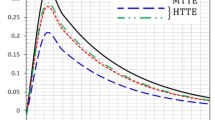Abstract
Gyarmati's principle is formulated in various pictures for the heat conduction phenomenon in solid. Since the heat current density and the internal energy function can be given in three different pictures for heat conduction phenomena, we get the nine forms of the principle from which the heat conduction equation can be derived. This formulation has been shown using the generalized Γ picture. In the subsequent section the principle is formulated in proper Γ picture from which three proper pictures namely Fourier, entropy and energy follow.
Zusammenfassung
Das Prinzip von Gyarmati wird in verschiedenen Arten für Wärmeleitphänomene formuliert. Da die Wärmestromdichte und die innere Energie in drei verschiedenen Arten für Wärmeleitphänomene angegeben werden können, erhalten wir die neun Formen des Prinzips, von denen die Wärmeleitgleichung abgeleitet werden kann. In dieser Formulierung wird ein verallgemeinertes Γ-Bild verwendet. Im folgenden Teil wird das Prinzip in einem geeigneten Γ-Bild formuliert, von dem drei geeignete Bilder folgen, nämlich das Fourier-, das Entropie- und das Energie-Bild.
Similar content being viewed by others
Abbreviations
- σ:
-
rate of entropy production
- ψ:
-
dissipation potential function of thermodynamic forces only
- Φ:
-
dissipation potential function of fluxes only
- v:
-
volume of the system
- x i :
-
thermodynamic forces
- J i :
-
thermodynamic currents
- f:
-
number of irreversible processes taking place in the system
- LiK :
-
phenomenological coefficients representing conductivity of the material
- RiK :
-
phenomenological coefficients representing resistances
- ρ:
-
density of the material
- a:
-
specific value of the extensive transport quantity
- Γi :
-
state parameters, the gradients of which give rise to the thermodynamic forces
- σi :
-
source density of ai
- s:
-
specific entropy
- T:
-
absolute temperature
- J q :
-
heat current density vector
- λ:
-
heat conductivity coefficient
- Lqq :
-
phenomenological coefficient corresponding to heat conductivity coefficient
- x q :
-
thermal dissipative force
- σq :
-
entropy production due to heat transfer
- u:
-
specific internal energy
- LΓ :
-
phenomenological coefficient in Γ picture
- cV :
-
specific heat at constant volume
References
Gyarmati, I.: On the most general form of the thermodynamic integral principle. Z. Phys. Chemie, 239 (1968) 133–137
Gyarmati, I.: On the governing principle of dissipative processes and its extension to non-linear problem. Ann. Phys. 23 (1969) 353–378
Gyarmati, I.: Non-equilibrium thermodynamics, Field theory and variational principles: Springer-Verlag, Berlin, Heidelberg, New York (1970)
Gyarmati, I.: Generalization of GPDP to complex scalar fields, Ann. Phys. 31 (1974) 18–32
Onsager, L.: Reciprocal relations in irreversible processes-I, Phys. Rev. 37 (1931) 405–421
Onsager, L.: Reciprocal relations in irreversible processes-II, Phys. Rev. 38 (1931) 2265–2279
Parkas, H.: The reformulation of the Gyarmati Principle in a generalized “Γ” picture: Z. Phys. Chemie, 239 (1968) 124–132
Singh, P.: The application of the GPDP to thermohydrodynamic stability: D. Sc. dissertation, Hungarian Academy of Sciences, Budapest, 1973
Singh, P.: The application of the GPDP to Benard convection, Int. J. Heat Mass Transfer 19 (1976) 581–588
Singh, P.: An approximate technique to thermohydrodynamic stability problem on the basis of GPDP; J. Non-Equilib. Thermodyn. 1 (1976) 105–116
Author information
Authors and Affiliations
Rights and permissions
About this article
Cite this article
Singh, P. Formulation of Gyarmati's principle for heat conduction equation. Wärme- und Stoffübertragung 13, 39–45 (1980). https://doi.org/10.1007/BF00997631
Received:
Issue Date:
DOI: https://doi.org/10.1007/BF00997631




